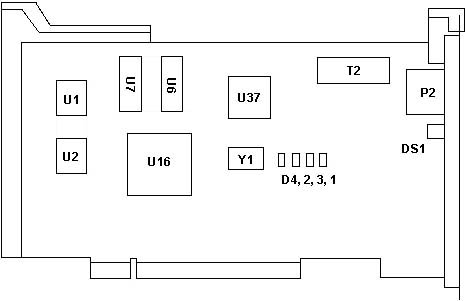|
Auto 16/4 Token-Ring
@E001.adf
IBM Auto 16/4 Token-Ring MC (more features) WARNING This file might
not be compatible to all older IBM TR-Adapters with Card-ID E001 and 'Tropic'-chipset
!
In case of doubt use the older E001-file
TRMAU1.EXE
Driver diskette
TRMAU2.EXE
Option diskette
Auto 16/4 Token Ring MC Adapter
PN 92G7695

D1-D4 Diodes
DS1 Status LEDs
P2 RJ45 Port
T2 Pulse PE-67523 Transformer
U1 92G7717 BIOS, Odd |
U2 92G7718 BIOS, Even
U6, U7 Motorola MCM6205DJ20
U16 10H4710
U37 50G7028
Y1 32.0000 MHz Osc |
LT00056
Error Message
Verify that the latest IBMTOK NDIS driver for the IBM Auto 16/4 Token-Ring
MC Adapter is being used. If there are no memory or interrupt conflicts,
this problem is usually caused by a downlevel NDIS driver. Use the
driver provided with the Auto 16/4 adapter.
Network Adapter LED Status
| Amber |
Green |
Explanation |
Blinking
(500ms) |
Blinking
(500ms) |
The adapter is active and waiting for initialization. |
| Off |
Off |
Adapter initialization in progress, computer is powered off, or adapter
is not active. Run LANAID and verify the adapter's configuration. |
| Off |
Blinking
(80ms) |
No problems detected during self-diagnostic
tests and adapter is waiting to open. If this occurs after adapter
opens, this indicates adapter is closed. |
| Off |
On |
The adapter is open and operating correctly. |
| On |
Off |
The adapter self-diagnostics tests failed or there is a problem with
the adapter. |
Blinking
(80ms) |
Off |
The adapter is closed. The adapter failed to open, detected a wire
fault or failed the auto-removal test. |
Blinking
(80ms) |
On |
The adapter has detected beaconing or a hard error. |
The Auto 16/4 Adapter transmits and receives data at a rate of either
4 or 16 Mbps over shielded twistet-pair (STP) or unshielded twisted-pair
(UTP) cable. The Auto 16/4 Adapter can be installed in either an 8-bit
or 16-bit slot.
Note: EUROPEAN USERS - If the adapter
is used with UTP cabling, you require cabling with a ferrite core (IBM
P/N 60G6059 or equivalent)
Cable Types Supported
This advanced line of token ring cards meets all of the electrical
transmitter and receiver requirements for 100 ohm, 120 ohm and 150 ohm
cabling which requires no impedance matching devices at 4 or 16 Mbit/s
speeds. One port can drive any of the three types of cabling specified.
Error Messages -
0166nnx0 - Primary Adapter / 0167nnx0 - Secondary Adapter
The values for nn are:
|
80
|
Invalid testing mode requested
|
|
81
|
Primary Adapter not present
|
|
82
|
Alternate Adapter not present
|
|
85
|
Configuration compare failure
|
|
90
|
Adapter Test failure
|
|
91
|
Open phase test failure
|
|
92
|
Computer problem
|
|
93
|
Transmit or receive test failure
|
|
99
|
General error
|
the x represents the slot number of the adapter in error
AdapterID E001 IBM Auto 16/4 Token-Ring
MC Adapter ver 1.00
Primary or Alternate adapter
Up to two Token-Ring Network adapters may be installed
in this computer. An adapter is either Primary (0A20-0A23), or Alternate
(0A24-0A27). If one Token-Ring Network adapter is installed, it may
be either Primary or Alternate. If two are installed, one must be
defined as Primary and the other Alternate.
<"Primary" (0A20 - 0A23)>,
Alternate (0A24 - 0A27)
Adapter Data Rate
You MUST set the adapter data rate to the same rate as
the Token-Ring segment to which you are connecting the adapter if Autosense
is set Off. If Autosense is set On, this setting is used as an initial
data rate to insert at after the configuration has changed.
It is recommended that you set the adapter rate the same as
the Token-Ring segment to which you are conecting the adapter, even if
Autosense is set to On.
<16 Mbps">, 4 Mbps
Autosense
This adapter can detect the ring speed of the Token-Ring
Segment. When Autosense is on, the adapter will atempt to determine the
ring speed to insert itself at. When off, the 'Adapter Data Rate'
setting determines the adapter data rate.
<"On">, Off
ROM Address Range
There are 12 possible 8K blocks used for accessing the
ROM area of the Token-Ring adapter. The preferred address is: CC000-CDFFF.
The ROM address selected must not be assigned for use by any other adapter
or option and cannot be the same as the RAM address for this adapter.
<"CC000-CDFFF">,
CE000-CFFFF, D0000-D1FFF, D2000-D3FFF, D4000-D5FFF, D6000-D7FFF, D8000-D9FFF,
DA000-DBFFF, DC000-DDFFF, DE000-DFFFF, C8000-C9FFF, CA000-CBFFF
RAM Size and Address Range
There are 30 possible blocks of memory that can be assigned
for accessing the RAM located on this adapter. The preferred RAM Size and
Address Range for the adapter, which allows RAM Paging, is: 16 KB / D8000-DBFFF.
The RAM Address Range must not be assigned for use by any other adapter
or option, and it cannot be the same as the ROM address for this adapter.
(Ed. all 8K windows are commented out)
<"16 KB / D8000-DBFFF">,
DC000-DFFFF, C0000-C3FFF, C4000-C7FFF, C8000-CBFFF, CC000-CFFFF, D0000-D3FFF,
D4000-D7FFF
32 KB / D8000-DFFFF, C0000-C7FFF,
C8000-CFFFF, D0000-D7FFF
64 KB / D0000-DFFFF, C0000-CFFFF
Interrupt Level
This adapter can operate on one of four interrupt levels:
2, 3, 10, or 11. The preferred interrupt level is 2, but the adapter
can operate on any of the four levels if necessary
< "Interrupt 2">,
3, 10, 11
Enable or Disable RPL
Ths adapter can be used in a medialess system by enabling
RPL or vice versa when chosing DISABLED. BEWARE:
if RPL is ENABLED, some high level software programs (eg. some server
software) may require that the adapter be configured as the primary adapter.
If your Token-Ring adapter has a separate RPL module socket,
the Enable or Disable RPL option will have no effect"
<"Enabled">, Disabled
9595 Main
Page
|